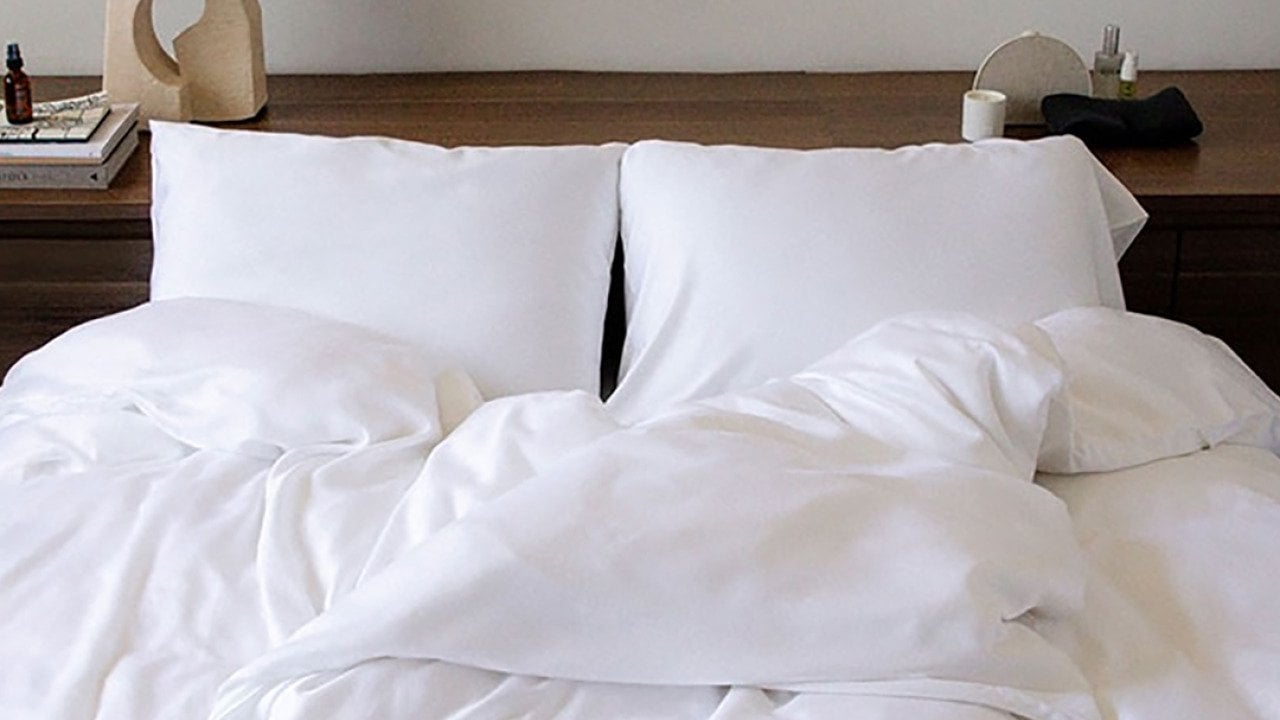The bedtime habit that’s saving relationships

Lunya
The bedtime habit that’s saving relationships
It often begins with a battle. Not over toothpaste caps, late-night texts, or who left the lights on. No, the real culprit is the seemingly innocent, but ever-shrinking duvet.
In the darkness, couples engage in a silent nightly war. Tug. Twist. Reclaim. Repeat. The collateral damage is frayed patience, poor rest, and, if science is to be believed, something even more serious. Health.
The Sleep Research Society reports that up to 30% of a person’s sleep quality is dictated by their partner’s sleep patterns, from erratic tossing to temperature shifts and seemingly criminal blanket theft. Meanwhile, a review in Sleep Medicine Reviews found that couples in conflict (not necessarily from arguments, but from unrest) experience significantly shorter, more disrupted sleep cycles. And the Centers for Disease Control and Prevention warns that chronic lack of quality rest can increase the risk of diabetes, obesity, heart disease, and depression.
In other words, this really isn’t just about comfort. The way people share (or don’t share) the covers can impact well-being. This is why couples worldwide are quietly turning to a decades-old Nordic custom that redefines what it means to share a bed.
Luxury loungewear retailer Lunya explains the Scandinavian Sleep Method.
What Is the Scandinavian Sleep Method?
For couples in Denmark, Sweden, and Norway, the concept isn’t revolutionary. It’s simply how people sleep. One bed. Two duvets. Better sleep on both sides of the bed.
Instead of treating a single blanket as a symbol of romantic unity, Scandinavian couples embrace separate duvets as a practical act of mutual respect. One partner runs hot, the other cold. One prefers the weighted embrace of down, the other wants a barely-there layer. The method acknowledges a universal truth: comfort isn’t one size fits all.
Relationship therapists have likened it to the sleep equivalent of separate bathroom sinks. Think of it not as an act of division, but a strategy for harmony. And sleep experts agree. Dr. Michael Gradisar, head of sleep science at Sleep Cycle, notes that nearly one-third of nighttime disruptions come from a partner’s movement alone, a problem drastically reduced by adopting two separate duvets.
“Separate covers don’t drive couples apart,” says one sleep psychologist. “They allow partners to sleep deeply, and paradoxically, connect more.”
The result? Less resentment. More rest. And, for many, a relationship that functions better both in and out of the bedroom.
Why the Shared Blanket Isn’t Always Romantic
In the U.S., the single shared duvet remains a cultural marker of intimacy. A cozy, cinematic shorthand for “look at us, we’re in sync.” But reality paints a different picture. Someone inevitably wakes up freezing and disgruntled while their partner cocoons in comfort, leaving a wake of micro-aggressions. You know the ones. A pointed sigh, a sharp yank, a not-so-subtle shift to the edge of the mattress.
Sleep psychologists consistently rank co-sleeping disturbances like snoring, body heat, shifting, cover-hogging among the top contributors to poor rest. And yet, couples endure it, fearing that separating duvets suggests a relationship on the rocks.
But as Scandinavian couples have quietly known for generations, sometimes the real marker of closeness is giving each other space.
How to Make It Look (and Feel) Effortless
Adopting two duvets doesn’t mean resigning your bedroom to an austere, mismatched fate. Scandinavian households have perfected the art of making a double-duvet bed look intentional.
One common layout: Fold each duvet lengthwise, lay them side-by-side, and face the openings outward. The result is symmetrical and quietly elegant, evoking the precision of origami. Another approach is to fold the second duvet and drape it across the foot of the bed like an accent throw. To visitors, it’s just a decorative touch; at night, it’s your secret weapon for uninterrupted rest.
Prefer top sheets? Keep one for your side. Duvet purist? Skip it. The method isn’t prescriptive, it’s adaptive.
“The Scandinavian Sleep Method isn’t a trend or a look,” says one sleep consultant. “It’s a sensibility: intentional, functional, and quietly luxurious.”
How to Start Sleeping, Scandi-Style
Getting started is simple. If you share a queen or king-sized mattress, pick up two twin-sized duvets. Breathable and temperature-regulating options work best to avoid overheating in your private cocoon. Place them side by side so they meet in the middle, or overlap slightly for a seamless look.
Then, personalize. Weighted on one side, airy linen on the other. Matching covers for cohesion, or complementary tones for contrast. The point isn’t to match preferences; it’s to respect them.
Not a Breakup, But Relationship Maintenance
For the uninitiated, separate duvets may feel like a metaphor for growing apart. But for many, it’s the opposite. Quality sleep leads to improved mood, greater patience, and yes, more interest in physical intimacy. In short, better rest makes people better partners.
Separate duvets aren’t about distancing from each other. They’re about closing the distance between how people live, love, and rest.
In a culture that equates sacrifice with devotion, the Scandinavian Sleep Method suggests a softer truth. Maybe you don’t need to compromise your sleep to prove your love. Maybe you can each have your own cover and still wake up tangled together, anyway.
This story was produced by Lunya and reviewed and distributed by Stacker.
![]()



